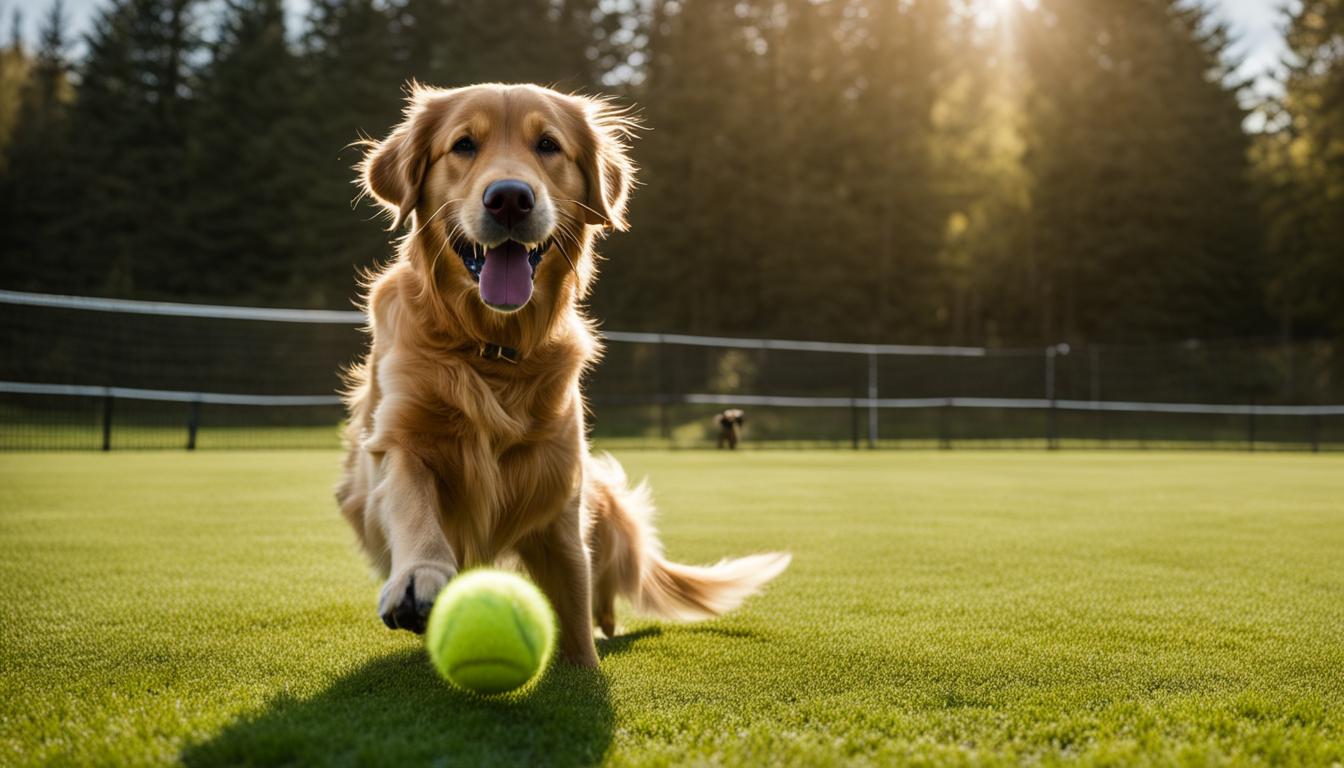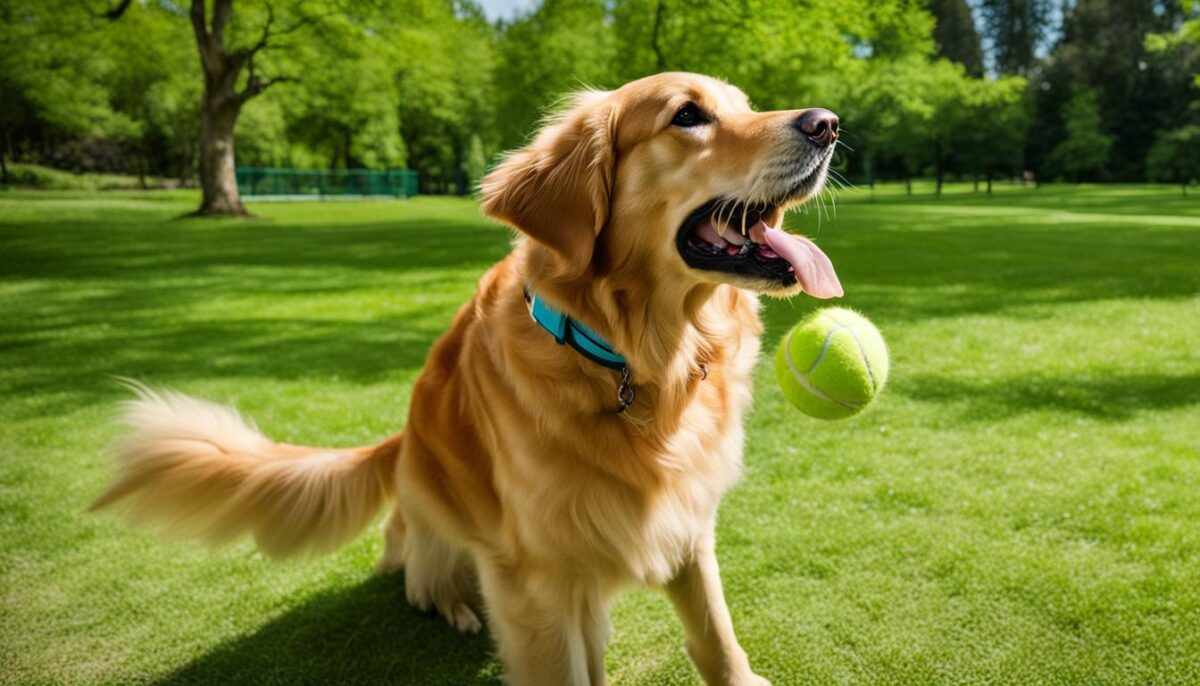Hey there! Do you want to play fetch with your dog? Great! Fetch can be a really fun game for you and your furry friend. Not all dogs know how to bring the ball back, but don’t worry. We can teach them together! It will be a game they love. You just need to take it slow and give them a treat when they do a good job.
To start, you will show your dog a toy that they will want to chase. Next, you will throw the toy and say “come” when they grab it. Then they will bring it to you. If they do it right, give them a treat and a pat. Do this many times, and soon your dog will be a fetch pro.
Key Takeaways
- You can teach your dog to play fetch even if they don’t know the game yet.
- Use a toy that your dog likes to start the fetch guide.
- Throw the toy a short way and say “come” to teach your dog fetch.
- Give your dog a treat when they bring the toy back to make fetch fun.
- Keep playing this dog retrieve game again and again, and be patient.
Preparing for Fetch Training
Before you start throwing toys for your furry friend to chase, let’s get everything ready. The right fetch toy selection can lead to many fun days ahead, and choosing the right treats helps teach your dog to bring the toy back. A good space to play is important too. Let’s get into the details!
Choosing the Right Fetch Toy
What does your pup love to play with? Balls, frisbees, plush toys? Every dog has their own toy preferences, and discovering your dog’s favorite is a part of the best toys for fetch. For some dogs, it’s the classic tennis ball, but others might love something they can chew on. Look for toys that are easy for your dog to carry in their mouth and safe for them.
Gathering Training Treats
Treats are like gold when it comes to reward-based dog training. You’ll want high-value dog treats that are small but tasty. Think of these treats as a ‘thank you’ for a job well done when your dog brings back the toy. Having a good treat selection means your dog will always be eager to learn more!
Understanding Your Dog’s Retrieval Instinct
Did you know some dogs, like Labradors and Golden Retrievers, seem to be born fetchers? It’s all about breed-specific fetching and dog retrieval instincts. But even if your dog isn’t one of these breeds, they can still join in the fun. It’s all about tapping into those dog play instincts.
Training Environment and Conditions
A safe dog training space matters. Start in a spot like your living room, where your dog can focus on training with fewer distractions. Once they’re good at fetch inside, try heading outside to a place like a fenced yard. This is what we call the ideal fetch environment—a safe spot where your dog can run and play to their heart’s content!
How to Train a Dog to Fetch
Playing fetch with your dog can be a fun way to spend time together. Let’s learn how to make your dog love this game. It’s easy!
Getting Your Dog Interested in the Toy
To start, engaging your dog with a toy is key. Show them the toy and be super happy about it. It’s like saying, “Look how cool this is!” When your dog sniffs or paws at the toy, tell them they’re doing great. This makes them excited to play more.
Encouraging the Initial Chase
Next, gently throw the toy a little bit away. Not too far, just enough to get your dog to run after it. That’s called initiating the dog chase. If your dog looks confused, roll the toy on the ground so they understand that they’re supposed to go get it.
Teaching the Command to ‘Come’ with Toy
When your dog has the toy and is looking at you, it’s time to use a special word. Say “come” or “bring it here” in a happy voice. This is part of fetch command training. When they come back to you, give them a tiny treat and lots of praise. This helps them learn what you want them to do.
Mastering the ‘Drop It’ Command
Now, the trick is to teach your dog to let go of the toy. Say “drop it” and wait. If they don’t let go, put your hand under the toy and wait. Patience is important! Only give them the treat after they drop the toy. This is what we call release toy training. Keep practicing, and they’ll get it!
Repeating for Consistency and Fun
Last part: do it again and again! Play fetch regularly to make the game a fun dog fetch routine. This will help your dog remember what to do every time. Always bring treats and remember to cheer for your dog when they do a good job. This makes them happy and ready to play more.
And that’s how you have a blast playing fetch with your dog while teaching them new tricks. Have fun and enjoy your time together!
Conclusion
Fetch is more than just a game. It’s a way to spend special time with your furry buddy and make your friendship even stronger. With each toss and return of the toy, you’re doing more than just playing—you’re helping your dog learn and stay healthy. Remember, some pups might not jump right into the game of fetch. That’s okay! They can still get the hang of it if you show them how fun it can be.
Think of dog fetch training as a step-by-step journey. You start small, reward each tiny win, and keep the mood happy. By doing this, you’re sure to see great results. And the best part? You’re creating joyful moments filled with dog playtime. That’s what really counts.
So, leap into fetch with a happy heart. Laugh and run with your dog. Each toss of the toy builds bonds with fetch, making memories that stick like a dog’s favorite treat. Go ahead and try it; fill your playtime with tail wags and high fives!
FAQ
How do I begin training my dog to fetch?
Start by introducing a toy to pique your dog’s interest. You want to engage them with a toy that excites them, using praise, treats, and interactive play to get them intrigued about the game of fetch.
What kinds of toys are best for training my dog to fetch?
The best toys for fetch are ones that your dog is naturally drawn to. This could be balls, plush toys, or even toys with treat compartments to entice them. Observing your dog’s toy preferences is key to selecting the right fetch toy.
Can I train any breed of dog to fetch?
Absolutely! While some breeds have natural retrieval instincts, such as Labradors and Golden Retrievers, with patience and the right motivation, most dogs can learn to play fetch.
What type of treats should I use during fetch training?
Use high-value treats that are small but packed with flavor to reward your dog during training. These treats are used to reinforce positive behaviors and encourage your dog to enjoy the fetch game.
Where is the best place to start fetch training?
It’s best to begin in a small, enclosed space to minimize distractions and help your dog focus on the game. You can gradually move to more open spaces as they become more skilled at fetching.
How do I get my dog interested in the toy?
Show excitement about the toy and encourage your dog to sniff and touch it. Use positive affirmations, clicks, or verbal praise paired with treats when they interact with the toy.
What should I do if my dog chases the toy but doesn’t bring it back?
Incorporate the recall command, such as “come” or “bring,” when your dog chases the toy. Reward them with treats and praise when they return the toy to you. Be patient; it may take multiple attempts for them to understand the game.
How can I teach my dog to drop the toy after fetching it?
Use a consistent command like “drop it.” Be patient and try holding out your hand as a cue. Reward your dog only once they release the toy into your hand to help them make the association.
How often should we practice fetch training?
Regular, consistent training sessions are key. Start with short periods and gradually increase the time as your dog becomes more familiar with the game. The consistency will help solidify the behavior.
Is the game of fetch beneficial for my dog?
Fetch is not only fun but also provides great mental and physical exercise for your dog, strengthening your bond and enhancing their obedience and skills.

